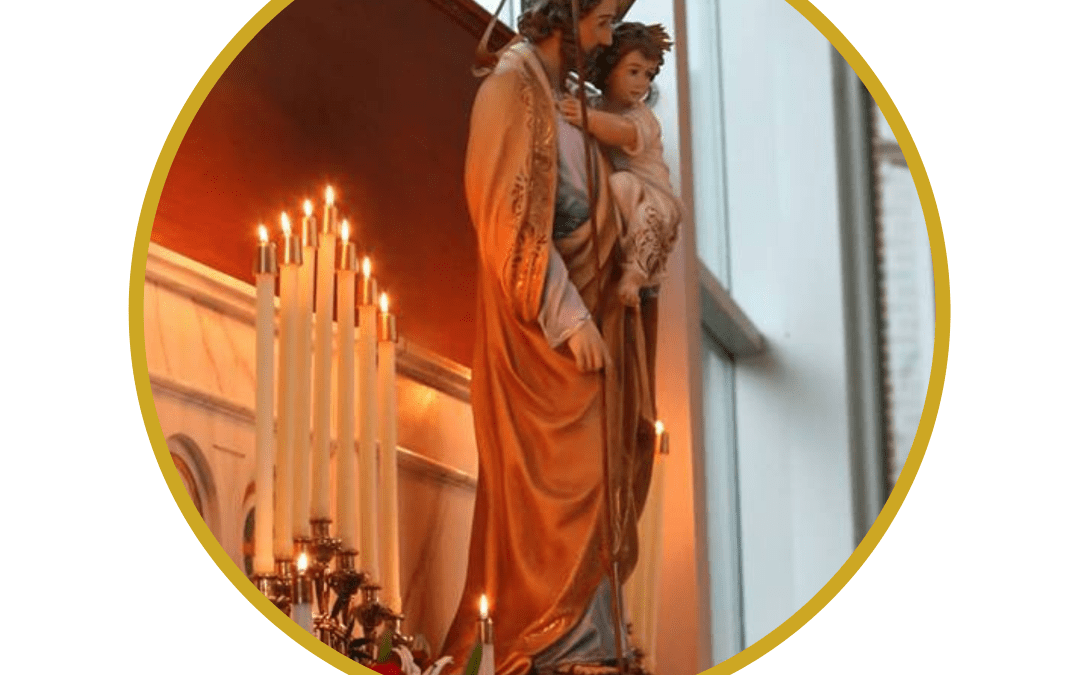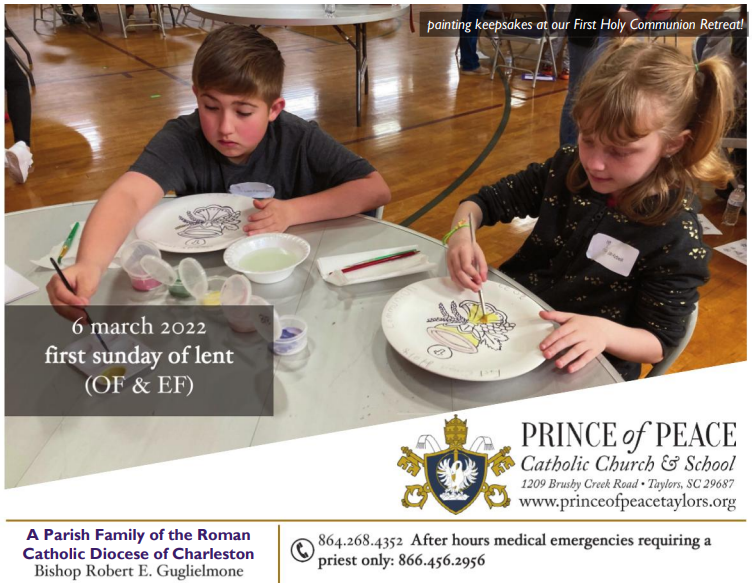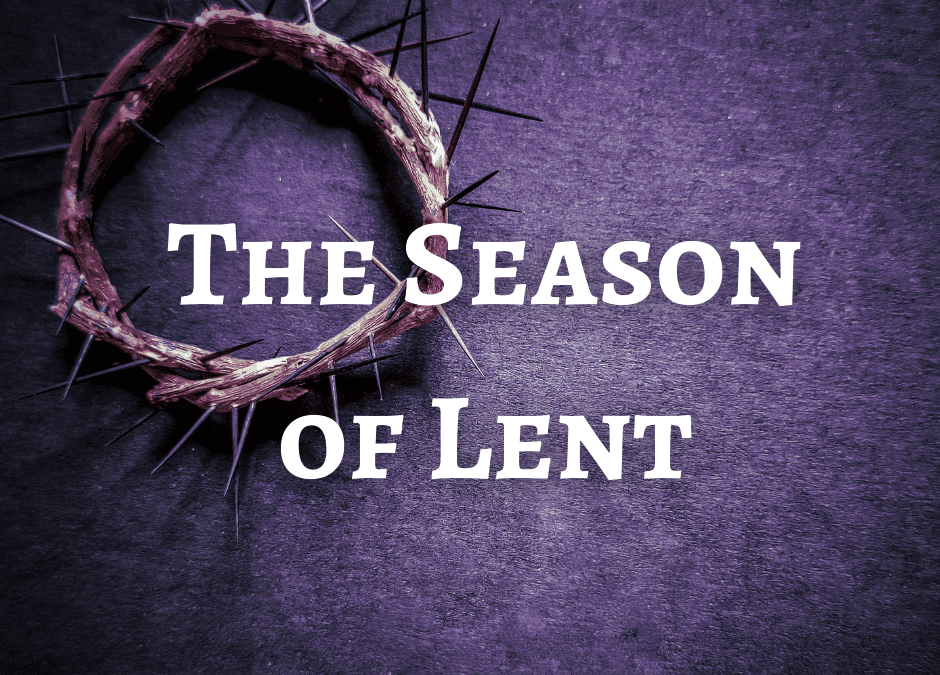
by popadmin | Mar 20, 2022 | Bulletin
Click to read this weekend’s bulletin: 20 March 2022 Bulletin

by popadmin | Mar 18, 2022 | CIC Saint Writeups
19 March: Solemnity of Saint Joseph. The Church celebrates two feast days for Saint Joseph: 19 March for Joseph the Husband of Mary and 1 May for Joseph the Worker. The 19th of March has been the more commonly celebrated feast; it wasn’t until 1955 that Pope Pius XII established the Feast of St. Joseph the Worker (1 May is also “May Day” – International Workers’ Day). Saint Joseph is well known as the head of the Holy Family. He is silent in scripture, yet, spoken words are not needed for us to understand his integrity and godliness. Here is what Pope Benedict XVI says: “The silence of Saint Joseph is given a special emphasis. His silence is steeped in contemplation of the mystery of God in an attitude of total availability to divine desires. It is a silence thanks to which Joseph, in unison with Mary, watches over the Word of God, known through the Sacred Scriptures, continuously comparing it with the events of the life of Jesus; a silence woven of constant prayer, a prayer of blessing of the Lord, of the adoration of His holy will and of unreserved entrustment to his providence. It is no exaggeration to think that it was precisely from his “father” Joseph that Jesus learned… Let us allow ourselves to be “filled” with Saint Joseph’s silence! In a world that is often too noisy, that encourages neither recollection nor listening to God’s voice.” Saint Joseph is the guardian and patron of the Universal Church, as well as of many causes including workers, fathers, and a happy death, due to the tradition that he died in Jesus and Mary’s arms.
“Inspired by the Gospel, the Fathers of the Church from the earliest centuries stressed that just as St. Joseph took loving care of Mary and gladly dedicated himself to Jesus Christ’s upbringing, he likewise watches over and protects Christ’s Mystical Body, that is, the Church.” – Pope St. John Paul II
Ideas for celebrating this feast:
- It is traditional to wear red for St. Joseph’s Day. Set the table with red cloths or candles and decorate the tabletop with tools and a sprinkle of sawdust (tip: breadcrumbs look like sawdust!). Place white lilies in your home to remember St. Joseph’s purity.
- Click here to see how to make a “St Joseph Altar” with all the traditional foods. Or, simply serve up sloppy Joe sandwiches as a fun way to remember Beloved Saint Joseph!
- Traditional St. Joseph’s day foodsinclude breads shaped in cross and staff form, figs, olives, dates, artichokes, fruits, salads, and sweets of all kinds especially donuts, cream puffs, biscotti and Italian cookies. For the main meal you could serve traditional fish and “St. Joseph’s Sawdust”: toasted bread crumbs over pasta, representing sawdust from St. Joseph’s workshop. Here’s a recipe.
- Children can do a craft building/making something out of wood (twigs, popsicle stick, etc) to remember Joseph’s work as a carpenter.
- In Italy and Spain, Father’s Day is celebrated annually on St. Joseph’s Day. Whatever man in your life has guided you or deepened your faith (whether it’s a biological father, adoptive father, foster father, grandfather, father-in-law or good priest): St. Joseph’s Day is a perfect day to honor them! Send a card; deliver a dinner; or offer a Mass in their honor.
- Give your worries to Joseph so you can get some rest: It is said that St. Joseph, the “Terror of Demons,” even frightens demons in his sleep, such is his power and strength! Ask St. Joseph to pray for you and take your worries away.
- Participate in the 33-day consecration to St. Joseph
- Pray the rosary with your family, saying the Litany of Saint Joseph at the end.
- Saint Joseph’s life is a model of Christian virtue. Perhaps we honor him best when we imitate his virtues (visit this website for insight into all of Joseph’s virtues).
- CELEBRATE THIS FEAST WITH YOUR POP FAMILY: On Saturday, 19 March after the 5pm Mass, come and join in the procession from church to the PAC. There will be dinner, a photo booth, and other fun activities to celebrate St. Joseph and all fathers!

by popadmin | Mar 9, 2022 | Bulletin
Click to read this week’s bulletin: 13 March 2022 Bulletin

by popadmin | Mar 5, 2022 | Bulletin
Click to read this week’s bulletin: 6 March 2022 Bulletin

by popadmin | Feb 27, 2022 | CIC Saint Writeups
Ideas for Observing Lent in the Domestic Church
LENT: a time to grow closer to God.
A time to take up practices that lead us toward him and to leave behind practices that distract us from him.
“Unless there is a Good Friday in your life, there can be no Easter Sunday.” – Ven. Fulton Sheen
“Apart from the cross, there is no other ladder by which we may get to heaven.” – St. Rose of Lima
- Read Prince of Peace Catholic Church’s The Shape of Lent and the Paschal Mystery 2022 and consider participating in the community-wide weekly sacrifices for Lent.
- Pray, go to mass, confession, and adoration of the Blessed Sacrament as often as you can.
- Read the Bible daily; even just a chapter a day! Read Scripture and stories of the saints to children.
- Home décor: your home can reflect the penitential season (use burlap; cactus instead of flowers; simple candles and religious items on tables, mantles, etc). Incorporate the liturgical color of purple.
- Movie sacrifice idea: instead of a favorite show, watch a Catholic saints story or a religious film (free with your parishioner FORMED account). Or, use that time to read about the Faith or lives of the saints.
- Make pretzels:pretzels were first baked during Lent (story here) because they can be made with water, flour, and salt. The shape came from a posture of prayer: arms crossed and hands on opposite shoulders. Recipe here.
- Save money to give to the poor: brainstorm ideas for how you can do this as a family. Perhaps eat at home instead of going out and give the extra $$ to charity. Are there little luxuries that can be sacrificed and the money donated? Some families might choose to do an offering jar. As a family, place all your spare change in the jar for the entire season of Lent, and let your kids put it in the offering plate on Easter Sunday.
- Pray the “Stations of the Cross” on Fridays. If you can’t go to the one at church, it is simple to pray them at home. Click here to print out the prayers (and pictures that children can color).
- Make a prayer chain: write a person or prayer request on 40 strips of paper. Assemble them into a paper chain. Remove one link per day, and pray for that thing with your kids.
- Build a Lenten Cross. Similar to an Advent wreath, you light one or more candles each night during dinner for the entire Lenten season.
- Sign up for “Holy Heroes” free Lenten adventure (kids ages 5-12): com
- Make a salt dough “crown of thorns” to place on your table: link here. For each Lenten sacrifice made, pull a toothpick out. The goal is to remove all the “thorns” by Easter. (Additionally, you can paint it gold and decorate with flowers where the “thorns” once were and use as an Easter centerpiece.)
- Bake an edible “crown of thorns” for Ash Wednesday or Good Friday: simply braid bread dough into a crown shape and bake. Push pretzel sticks (‘thorns’) into the crown as soon as it comes out of the oven. (idea here)
- Similar to the crown of thorns activity, you could also do “sacrifice beans.” On the table is a bowl filled with dried beans next to a jar. When you make a sacrifice for Jesus, put a bean in the jar. Then, on Easter morning, children wake up to find that the beans that have accumulated in the jar during Lent have been changed into yummy jelly beans (or other such candies).
- Make some empty tomb crafts with kids. Try this Calvary Hill Plant that grows throughout Lent. Decorate with flowers on Easter morning and add a little statue of Jesus outside the empty tomb to represent the risen Lord. Click here for more. Kids love this fun project and you can use it as your Easter centerpiece!
- Try to set a daily goal to sacrifice in these areas:
- Diet: sacrifice a food or drink you love
- Physical: do something physically difficult every day (push-ups; daily walk; run a mile; etc.)
- Spiritual: spend daily time with God in prayer and Scripture
“The Lord measures out perfection neither by the multitude nor the magnitude of our deeds, but by the manner in which we perform them.” – St. John of the Cross

by popadmin | Feb 26, 2022 | Bulletin
Click to read this week’s bulletin: 27 February 2022 Bulletin







Recent Comments